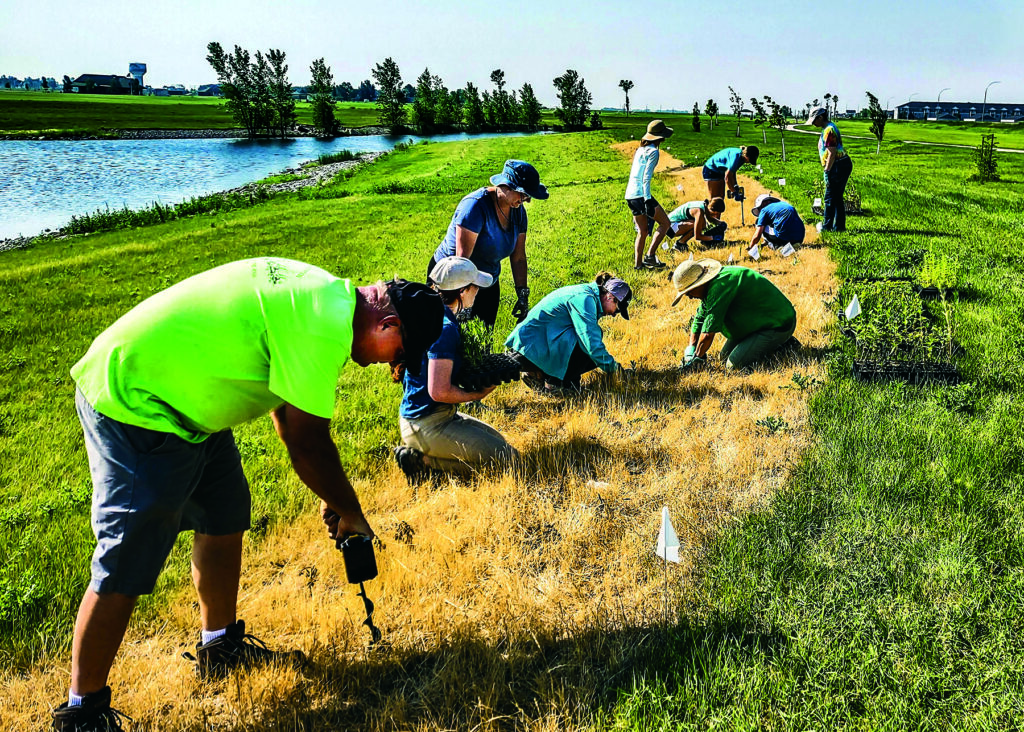 Nancy Edmonds Hanson
Nancy Edmonds Hanson
Acres of modern turf grass – tended and utterly uniform – define the landscape of most of Moorhead’s parklands, as well as lawns throughout the city. But to the relief of those concerned about nurturing the butterflies, bees and multitude of other insects that pollinate the plants around us, that has slowly begun to change.
The latest sign of the reinvigoration of native prairie plants showed up last week in Moorhead’s Southside Regional and M.B. Johnson Parks. There, volunteers and restoration advocates planted the first of what will become 15 acres of the kind of habitat that once flourished here – flowers, grasses and broadleaf plants that can trace their roots to the days before industrial agriculture and monoculture turf grass came to dominate the Red River Valley soil.
According to Moorhead sustainability coordinator Crystal Rayamajhi, crews of volunteers – including many from River Keepers and Audubon Dakota, and with the help of a crew from the United Prairie Foundation in Enderlin, North Dakota – planted 2,800 plugs of native species in Southside Regional Park last week. The seedlings and rooted cuttings, each in its cylinder of soil, will by next year line the north edge of the stormwater pond with vigorous two-foot growth drawing Monarch butterflies, several species of native bees and countless other insects. The new prairie will also control erosion, reduce mowing costs, improve filtration of water runoff, and add aesthetically pleasing views around the stormwater pond.
Blooms will add a splash of color to the otherwise all-green landscape, though visitors will have to ditch their cars and walk the parks’ paths to enjoy them. The Southside Park planting is in a small depression in the far northwestern corner of the otherwise-flat park, not visible from the park’s roadways or adjacent 20th Street South.
“There’s so much energy around pollinators in our community right now,” the sustainability coordinator says. She partially credits the concern over 2020’s “Monarch massacre,” in which poorly timed citywide spraying killed thousands of the butterflies, for focusing attention “It shone a bright light on the plight of pollinators. Now we’re working hard to carry out the mayor’s Monarch pledge.” That statement of concern, enacted a year ago, has led not only to the prairie restoration but to city participation in a state program to reimburse homeowners who dedicate part of their yards to restoring pollinator habitat.
The push to restore patches of prairie, Rayamajhi says, is funded by about $50,000 in grants, including funding by the Bush Foundation secured by the city’s Resiliency Task Force, Wildlife Forever and the Minnesota Department of Natural Resources’ Conservation Partners Legacy Grant. It evolved as the second phase of the task force’s working group on ecological systems; the first phase, the Food Forest at M.B. Johnson Park was largely completed last year.
Guiding the local team is John DeVries of the United Prairie Foundation, which focuses on identifying, propagating and tending the authentic plants that once thrived in this area. “When people plant natives, they’re not always specifically local to our region,” Rayamaji explains. “John is passionate about the plants that actually belong here, supporting the insects that inhabit this specific area.”
Among the species chosen for the Southside location are colorfully named varieties like hoary vervain, spiderwort, hyssop, ironweed, sunflowers and culver’s root. The coordinator notes that each may support as many as five species of insects. A team from the United Prairie Foundation will keep an eye on the transplants for the next three years, she explains, as they sink their roots in Moorhead soil. “The prairie will eventually be able to fight back against invasive species and other threats, but that takes time. As these plants build their biomass beneath the soil and above it, they need a little help so that they don’t get choked out.
Rayamajhi expects the prairie planting to continue and perhaps expand in coming years. “We’re taking areas that can’t be used immediately for recreation. It enhances the overall look of the parks,” she says, adding that the better the mix of plants in the prairie, the more species that can thrive.
Incorporating native plantings is also part of the city’s comprehensive plan. Rayamajhi hopes that the current plantings are just the beginning of bigger things to come: “We’ll see how it goes, and will expand it as opportunities arise.”


